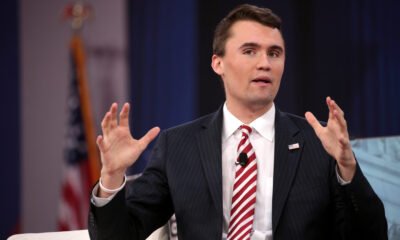Politics
Bill Aims to Strip Convicted Felons of Secret Service Protection
Washington, D.C. – In a significant legislative move, Rep. Bennie G. Thompson (D-MS), Ranking Member of the Committee on Homeland Security, has introduced the *Denying Infinite Security and Government Resources Allocated toward Convicted and Extremely Dishonorable Former Protectees Act* (DISGRACED Former Protectees Act). This bill aims to address a critical gap in current U.S. law regarding Secret Service protection for convicted felons who are sentenced to prison.
Under existing law, the Secret Service is mandated to protect former presidents and other high-level officials, even if they are convicted of a felony. The DISGRACED Former Protectees Act seeks to terminate such protection if the individual is convicted of a felony and sentenced to prison.
Key Provisions of the DISGRACED Former Protectees Act
1. Automatic Termination of Protection: The Act would automatically end Secret Service protection for any former protectee, including former presidents, who are sentenced to prison following a felony conviction. This provision ensures that convicted individuals do not receive special treatment due to their previous status.
2. Responsibility Shift: Once Secret Service protection is terminated, the responsibility for the protection of the convicted individual would shift to prison authorities. This change ensures that the individual is treated like any other inmate, maintaining the integrity of the prison system and the justice process.
3. Legislative Intent: The legislation is designed to ensure that protective status does not result in special treatment for convicted felons. By updating the law, the bill aims to maintain the integrity of the justice system and ensure that all individuals serve their sentences as required, without the complications of Secret Service protection.
Context and Implications
This legislative move comes in the context of former President Donald J. Trump’s recent conviction on 34 felony counts of falsifying business records. The historic conviction has raised questions about the implications of Secret Service protection if he were to be sentenced to prison. Under current law, the Secret Service would be responsible for protecting him within prison premises, a scenario that presents significant logistical and legal challenges.
Rep. Thompson emphasized the necessity of the legislation, stating, “Unfortunately, current law doesn’t anticipate how Secret Service protection would impact the felony prison sentence of a protectee—even a former President. It is regrettable that it has come to this, but this previously unthought-of scenario could become our reality. Therefore, it is necessary for us to be prepared and update the law so the American people can be assured that protective status does not translate into special treatment—and that those who are sentenced to prison will indeed serve the time required of them”.
Political Reactions
The introduction of the DISGRACED Former Protectees Act has sparked a range of political reactions. Governor Tate Reeves (R-MS) criticized the legislation, calling it “truly shameful, outrageous, and a new low for the leftwing in America.” He argued that the bill could leave former President Trump vulnerable to assassination attempts, a claim that has been met with both support and opposition from various political figures.
Despite the controversy, the bill has garnered support from several Democratic co-sponsors, including Reps. Troy A. Carter Sr., Barbara Lee, Frederica Wilson, Yvette D. Clarke, Bonnie Watson Coleman, Jasmine Crockett, Joyce Beatty, and Steve Cohen. They argue that the legislation is necessary to ensure the fair administration of justice and to prevent any individual from receiving preferential treatment due to their former status.
Conclusion
The DISGRACED Former Protectees Act represents a significant step in addressing the complexities of providing Secret Service protection to convicted felons. By terminating such protection upon sentencing, the legislation aims to uphold the principles of justice and equality, ensuring that all individuals, regardless of their past positions, are subject to the same legal standards and treatment.
As the bill moves through the legislative process, it will undoubtedly continue to generate debate and discussion about the balance between security, justice, and the rule of law in the United States.
Stay Connected
Politics
Divided and Deadly: When Political Hatred Turns Fatal

America’s political divide is no longer just a metaphor—it’s now a measurable, chilling reality. In recent weeks, a relentless barrage of violence has brought headline after headline: the assassination of Charlie Kirk on September 10th, bomb threats and failed attempts targeting news crews, shootings at public gatherings, attacks on federal agents, and online mobs openly glorifying the carnage. What once seemed fringe or exceptional is now undeniably mainstream. The unthinkable is becoming all too routine.
Consider this: within days of Kirk’s assassination, a Fox News van parked at the crime scene in Utah was targeted by a bomb that narrowly failed to detonate, followed by bomb threats at the home of presidential candidate RFK Jr. Shootings tied to political slogans erupted at a New Hampshire country club and inside a news station, with attackers leaving manifestos and warning that “Trump officials would be next.” Meanwhile, federal ICE agents were ambushed in Chicago by carloads of heavily armed assailants—another event spun by legacy media as if it was government aggression, rather than a defensive response to an act of terror.

This surge in violence is not happening in a vacuum. It emanates from decades of tolerated, even celebrated, dehumanization across the political spectrum. But, in Brett Cooper’s telling—and in the disturbing texts and rhetoric unearthed in the wake of these tragedies—the epicenter appears to be one party’s willingness to excuse, justify, or even cheer political assassination. Cooper highlights not just one-off outbursts, but prominent Democratic politicians openly wishing death and horror on their opponents, their families, and even their children. The infamous leaked texts from Virginia’s Jay Jones—expressing desire to see innocent children die “so that their father would change his opinions”—read like a dystopian novel come to life. Yet, defenders line up, brushing it off as “mistakes” and framing any criticism as partisan smears.
How did this become the new normal? The left, argues Cooper, has marinated in a protest culture that sanctifies violence as a substitute for persuasion. Losing an election, a court case, or a policy fight now justifies open calls for revenge. Online, the rhetoric is as gruesome as the reality, with political adversaries not simply derided, but declared subhuman and unworthy of life—a chilling echo of history’s darkest chapters.
Of course, political violence can never be blamed on rhetoric or ideology alone. But words have consequences. Leaders who flirt with calls for violence set the tone for every zealot and unstable mind. The celebration of real-world killings by online mobs only entrenches a cycle where each incident of bloodshed is either weaponized or excused, not universally condemned.
Perhaps most dangerous is the media’s shifting lens—the effort to muddy attacks with claims of ambiguity about motive or to frame self-defense by government officers as wanton aggression. The danger isn’t just physical, but moral and cultural: when outrage at assassination gives way to tribal excuses, a nation chips away at its own foundation.
In a world this divided and deadly, Cooper’s advice feels both practical and poignant: focus on the real, the local, the communal. Sit down with family. Turn down the temperature wherever possible. Call out inhumanity—no matter who it comes from.
America’s most urgent debate is not just about policy, but about whether political disagreement must now also mean existential threat. If ever there was a time for collective soul-searching, it is now—when headlines show, beyond a shadow of a doubt, that political hatred can, and does, turn fatal.
News
How a Government Shutdown Could Hit Your Life and Wallet

What a Shutdown Means for You
When Washington can’t agree on funding, government operations grind to a halt—and millions feel the ripple effects. Whether employed by a federal agency, planning a trip, or just waiting for a tax refund, the shutdown’s reach can extend into daily life in unexpected ways.

Paychecks and Local Economies
Federal employees are on the frontline, facing furloughs or delayed pay. If you or someone in your household works for the government, this means missed or postponed earnings—sometimes for weeks. Local businesses feel the squeeze when those employees cut back on spending, and contractors dependent on federal clients might also see sudden layoffs and lost projects.
Services and Everyday Disruption
From longer airport lines to shuttered national parks, public services can stall or close entirely. Waiting on a passport renewal, Social Security verification, or a student loan application? Those processes may be paused, causing headaches and delays that interrupt travel plans, business operations, or educational goals.
Health Care Worries
Shutdowns often spark fierce debates over health care policy. If negotiations stall, federal insurance tax credits could vanish, causing health premiums to spike for millions. For some, especially those relying on government-supported coverage, this means losing insurance altogether—a risk that could affect up to four million Americans if deadlock persists.
Impact on the Economy and Markets
Travel slows as essential agencies are stretched thin and parks close, costing the travel industry as much as $1 billion each week the shutdown lasts. Economic data releases used by the Federal Reserve and investors can also be delayed, muddying the outlook for businesses and individuals watching inflation or employment figures.
The Real-Life Cost
A government shutdown isn’t just a political fight—it’s an event that can upend plans, impact paychecks, delay vital services, and create stress for families nationwide. History shows most communities bounce back, but for those caught in the crossfire, the effects are personal and immediate.
Politics
Netanyahu’s UN Speech Triggers Diplomatic Walkouts and Mass Protests

What Happened at the United Nations
On Friday, Israeli Prime Minister Benjamin Netanyahu addressed the United Nations General Assembly in New York City, defending Israel’s ongoing military operations in Gaza. As he spoke, more than 100 delegates from over 50 countries stood up and left the chamber—a rare and significant diplomatic walkout. Outside the UN, thousands of protesters gathered to voice opposition to Netanyahu’s policies and call for accountability, including some who labeled him a war criminal. The protest included activists from Palestinian and Jewish groups, along with international allies.

Why Did Delegates and Protesters Walk Out?
The walkouts and protests were a response to Israel’s continued offensive in Gaza, which has resulted in widespread destruction and a significant humanitarian crisis. Many countries and individuals have accused Israel of excessive use of force, and some international prosecutors have suggested Netanyahu should face investigation by the International Criminal Court for war crimes, including claims that starvation was used as a weapon against civilians. At the same time, a record number of nations—over 150—recently recognized the State of Palestine, leaving the United States as the only permanent UN Security Council member not to join them.
International Reaction and Significance
The diplomatic walkouts and street protests demonstrate increasing global concern over the situation in Gaza and growing support for Palestinian statehood. Several world leaders, including Colombia’s President Gustavo Petro, showed visible solidarity with protesters. Petro called for international intervention and, controversially, for US troops not to follow orders he viewed as supporting ongoing conflict. The US later revoked Petro’s visa over his role in the protests, which he argued was evidence of a declining respect for international law.

Why Is This News Important?
The Gaza conflict is one of the world’s most contentious and closely-watched issues. It has drawn strong feelings and differing opinions from governments, activists, and ordinary people worldwide. The United Nations, as an international organization focused on peace and human rights, is a key arena for these debates. The events surrounding Netanyahu’s speech show that many nations and voices are urging new action—from recognition of Palestinian rights to calls for sanctions against Israel—while discussion and disagreement over the best path forward continue.
This episode at the UN highlights how international diplomacy, public protests, and official policy are all intersecting in real time as the search for solutions to the Israeli-Palestinian conflict remains urgent and unresolved.

 Business3 weeks ago
Business3 weeks agoDisney Loses $3.87 Billion as Subscription Cancellations Surge After Kimmel Suspension

 Entertainment3 weeks ago
Entertainment3 weeks agoWhat the Deletion Frenzy Reveals in the David and Celeste Tragedy

 Filmmaking4 weeks ago
Filmmaking4 weeks agoThe Real Reasons Film Jobs Are Disappearing

 Entertainment4 weeks ago
Entertainment4 weeks agoABC Suspends ‘Jimmy Kimmel Live!’ Indefinitely After Kirk Remarks

 Tech4 weeks ago
Tech4 weeks agoWhy Experts Say AI Could Manipulate, Blackmail, and Even Replace Human Relationships

 News4 weeks ago
News4 weeks agoSeeing Trauma: What Charlie Kirk’s Death Reveals About a Nation in Conflict

 Entertainment3 weeks ago
Entertainment3 weeks agoExecutive Producer Debut: How Celia Carver Created Festival Hit ‘Afterparty’

 Filmmaking4 weeks ago
Filmmaking4 weeks agoWhy Hollywood’s Biggest Blockbusters Keep Failing at the Box Office







































